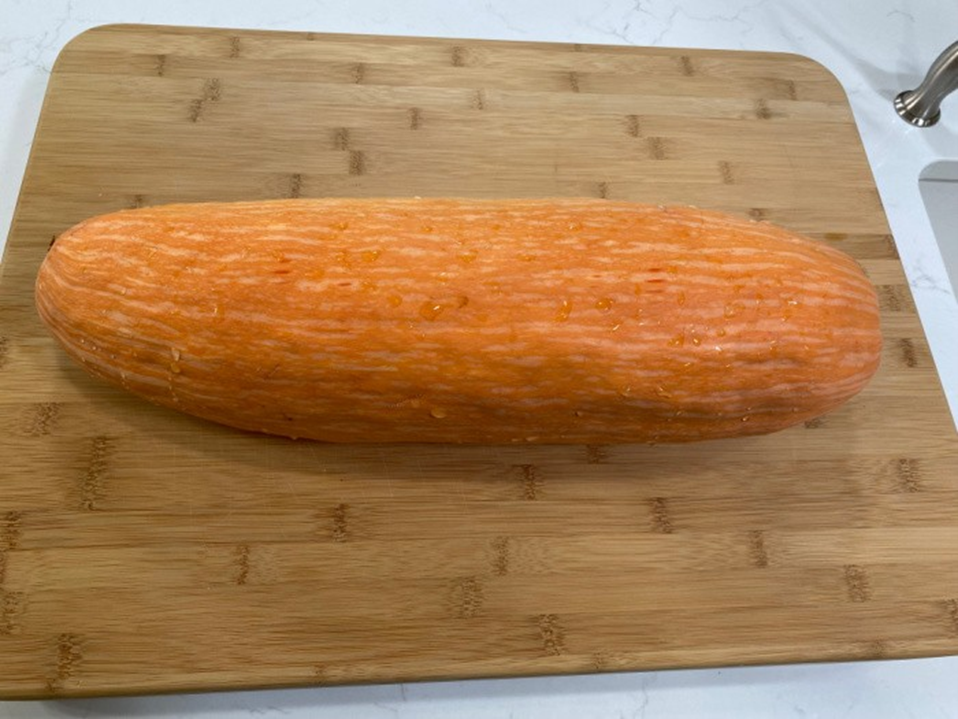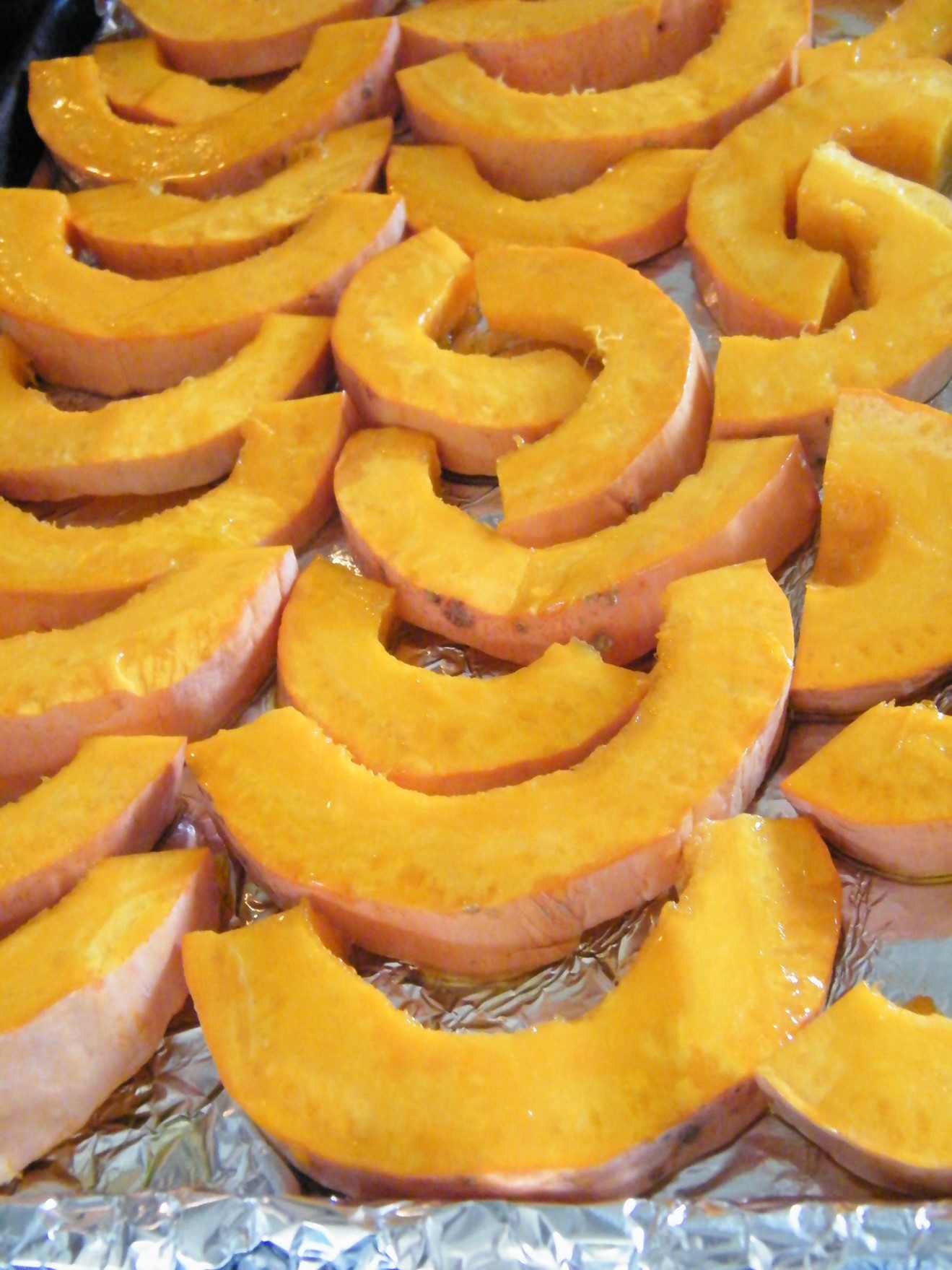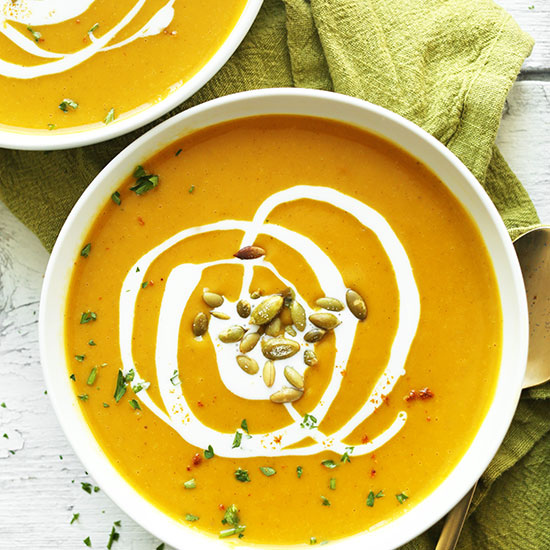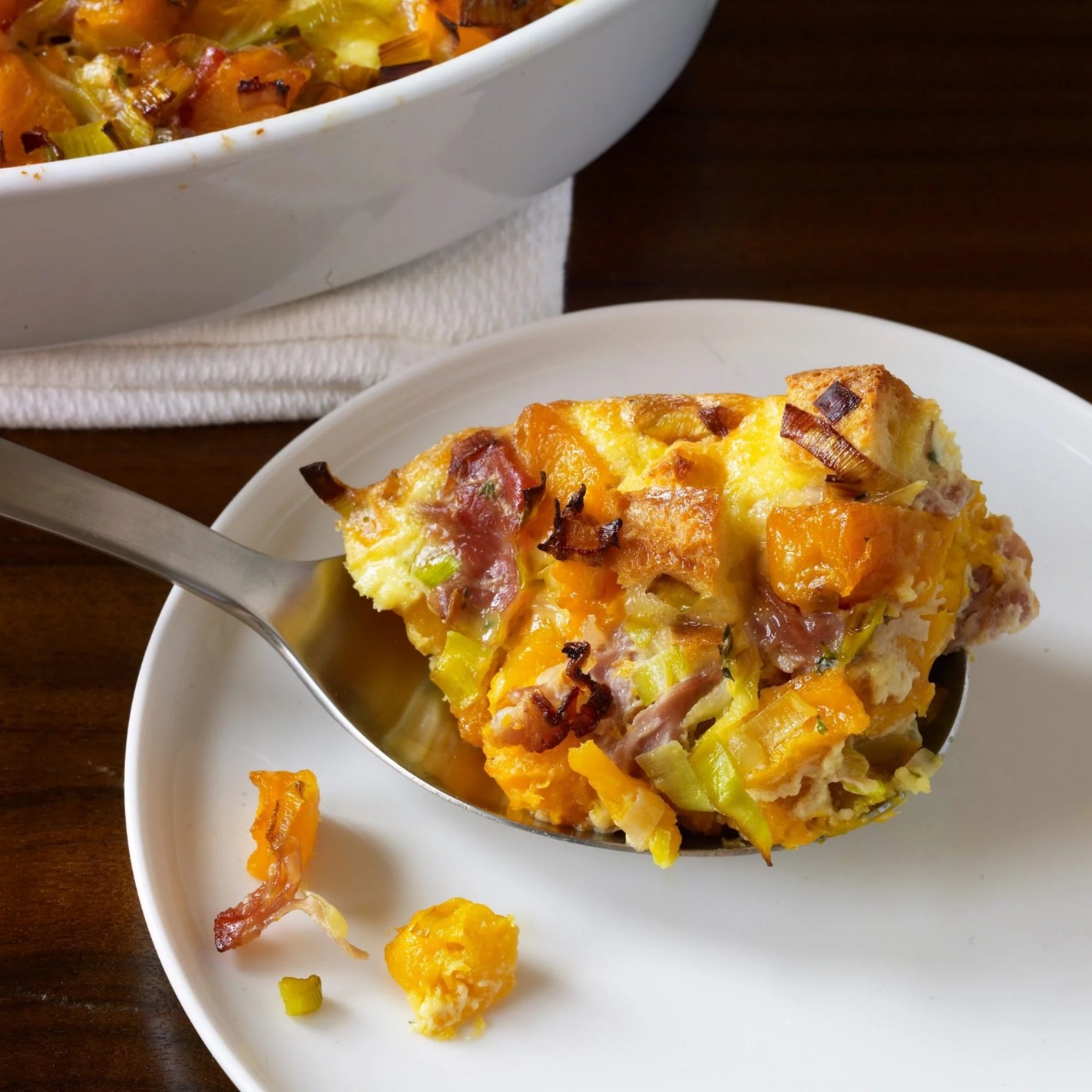Going Bananas Over Banana Squash
Food fresh from the garden, someone else’s garden, or the farmers’ market—I go bananas over it. But I especially go bananas over banana squash. And I’ll tell you why:

This superior vegetable is fat free, saturated fat free, cholesterol free, sodium free, an excellent source of vitamin A, and a great source of vitamin C. It’s high in fiber and phytonutrients as well as containing an abundance of trace elements. Its health-promoting factors are as big as it is!
Did I say BIG? As you probably know, banana squash can grow to be very LARGE, averaging 30 to 40 pounds and up to 3 feet long. Those most commonly found in the grocery stores are lots smaller, however. The thick-walled rind is smooth and depending on variety, can be salmon pink, blue, yellow, or variegated in color. The orange flesh is firm, dense, and meaty with a hollow seed cavity encasing stringy pulp and cream-colored, hard, flat, and oblong, small seeds. When cooked, the flesh of the banana squash is fragrant, dry, rich, and earthy sweet.

You can slice it and store it in plastic bags in the fridge for up to a week. If you’re buying it, choose one that’s firm and fairly heavy for its size. Look for squash that has a bright, glossy exterior. And as with any produce purchases, always avoid buying squash with nicks, bruises or soft spots.

But besides being tasty and healthy, this marvelous squash is like all in the squash family, extremely versatile. You can turn it into soup and add it to all sorts of stews. When cooked, you can dice it and fold it into cooked rice. It also makes a delicious addition to poultry dressing. However, if you don’t want to stuff poultry, stuff the squash. Just fill the cavity with cooked grain casserole filling and bake.
And it’s mild and pleasant flavor pairs really well with leeks. Here’s a recipe family and friends applaud that Aunt Annie adapted over time from a few assorted recipes:

3 pounds banana squash peeled, seeded and cut into 1/2-inch dices (butternut or acorn squash will work as well)
2 tablespoons extra virgin olive oil divided
2 tablespoons finely chopped fresh thyme divided
kosher salt to taste
freshly ground black pepper to taste
1 tablespoon unsalted butter
3 leeks white and light green parts only, halved lengthwise and thinly sliced crosswise (about 4 cups)
6 large eggs
2 1/2 cups half and half
1/3 cup freshly grated Parmigiano Reggiano cheese
8 ounces baguette crusts removed and bread cut into 1/2-inch dice
4 ounces thinly sliced prosciutto or deli ham, cut into thin strips
Directions:
Add Recipe to Cook'n
But this recipe only uses up about 3 of those 7 or 8 pounds of that huge squash we’re talkin’ about. So, what to do with the rest of it? I like to bake it and then puree it in my blender. From there I go my tried-and-true ice cube tray route. I pour the puree into all my ice cube trays and freeze it. When solid, I transfer the squash cubes to zippered plastic freezer bags and return it all to the freezer.
Then throughout the rest of the year I use these vitamin-loaded cubes in my green smoothies, add them to soups and stews, and even fold them into quick breads and muffins (they become the liquid portion of my recipes). How you use these is really only limited to your imagination.

That’s what’s so great about banana squash—its versatility makes it the perfect food for putting your imagination to work. That said, here’s one last idea with which I’ll close: Blend 2 or 3 frozen (or not) cooked banana squash cubes or dices with 1/3 cup of orange juice concentrate and 2 or 3 cups of vanilla-flavored Greek yogurt. Take a sip of this and you’ll see why I go bananas over banana squash!

This superior vegetable is fat free, saturated fat free, cholesterol free, sodium free, an excellent source of vitamin A, and a great source of vitamin C. It’s high in fiber and phytonutrients as well as containing an abundance of trace elements. Its health-promoting factors are as big as it is!
Did I say BIG? As you probably know, banana squash can grow to be very LARGE, averaging 30 to 40 pounds and up to 3 feet long. Those most commonly found in the grocery stores are lots smaller, however. The thick-walled rind is smooth and depending on variety, can be salmon pink, blue, yellow, or variegated in color. The orange flesh is firm, dense, and meaty with a hollow seed cavity encasing stringy pulp and cream-colored, hard, flat, and oblong, small seeds. When cooked, the flesh of the banana squash is fragrant, dry, rich, and earthy sweet.

You can slice it and store it in plastic bags in the fridge for up to a week. If you’re buying it, choose one that’s firm and fairly heavy for its size. Look for squash that has a bright, glossy exterior. And as with any produce purchases, always avoid buying squash with nicks, bruises or soft spots.

But besides being tasty and healthy, this marvelous squash is like all in the squash family, extremely versatile. You can turn it into soup and add it to all sorts of stews. When cooked, you can dice it and fold it into cooked rice. It also makes a delicious addition to poultry dressing. However, if you don’t want to stuff poultry, stuff the squash. Just fill the cavity with cooked grain casserole filling and bake.
And it’s mild and pleasant flavor pairs really well with leeks. Here’s a recipe family and friends applaud that Aunt Annie adapted over time from a few assorted recipes:

Banana Squash and Leek Casserole
Ingredients:
3 pounds banana squash peeled, seeded and cut into 1/2-inch dices (butternut or acorn squash will work as well)
2 tablespoons extra virgin olive oil divided
2 tablespoons finely chopped fresh thyme divided
kosher salt to taste
freshly ground black pepper to taste
1 tablespoon unsalted butter
3 leeks white and light green parts only, halved lengthwise and thinly sliced crosswise (about 4 cups)
6 large eggs
2 1/2 cups half and half
1/3 cup freshly grated Parmigiano Reggiano cheese
8 ounces baguette crusts removed and bread cut into 1/2-inch dice
4 ounces thinly sliced prosciutto or deli ham, cut into thin strips
Directions:
1. Preheat the oven to 400°
2. Butter a 9-by-13-inch ceramic baking dish.
3. In a large bowl, toss the butternut squash with 1 tablespoon of the olive oil and the thyme. Season with salt and pepper.
4. Spread the squash on a baking sheet in a single layer and roast for about 25 minutes, until tender, tossing once halfway through. Let cool.
5. Meanwhile, in a medium skillet, melt the butter in the remaining 1 tablespoon of olive oil.
6. Add the leeks and season with salt and pepper. Cook over moderate heat, stirring, until tender, about 20 minutes. Let cool slightly.
7. In a large bowl, beat the eggs with the half-and-half, cheese, 1 teaspoon of salt and a 1/2 teaspoon of pepper. Stir in the bread and let stand for 10 minutes.
8. Fold in the squash, prosciutto and the cooled leeks. Transfer the mixture to the prepared baking dish
9. Bake for about 1 hour, until lightly golden on top.
10. Let stand for 15 minutes before serving.
2. Butter a 9-by-13-inch ceramic baking dish.
3. In a large bowl, toss the butternut squash with 1 tablespoon of the olive oil and the thyme. Season with salt and pepper.
4. Spread the squash on a baking sheet in a single layer and roast for about 25 minutes, until tender, tossing once halfway through. Let cool.
5. Meanwhile, in a medium skillet, melt the butter in the remaining 1 tablespoon of olive oil.
6. Add the leeks and season with salt and pepper. Cook over moderate heat, stirring, until tender, about 20 minutes. Let cool slightly.
7. In a large bowl, beat the eggs with the half-and-half, cheese, 1 teaspoon of salt and a 1/2 teaspoon of pepper. Stir in the bread and let stand for 10 minutes.
8. Fold in the squash, prosciutto and the cooled leeks. Transfer the mixture to the prepared baking dish
9. Bake for about 1 hour, until lightly golden on top.
10. Let stand for 15 minutes before serving.
Recipe formatted with the Cook'n Recipe Software from DVO Enterprises.
But this recipe only uses up about 3 of those 7 or 8 pounds of that huge squash we’re talkin’ about. So, what to do with the rest of it? I like to bake it and then puree it in my blender. From there I go my tried-and-true ice cube tray route. I pour the puree into all my ice cube trays and freeze it. When solid, I transfer the squash cubes to zippered plastic freezer bags and return it all to the freezer.
Then throughout the rest of the year I use these vitamin-loaded cubes in my green smoothies, add them to soups and stews, and even fold them into quick breads and muffins (they become the liquid portion of my recipes). How you use these is really only limited to your imagination.

That’s what’s so great about banana squash—its versatility makes it the perfect food for putting your imagination to work. That said, here’s one last idea with which I’ll close: Blend 2 or 3 frozen (or not) cooked banana squash cubes or dices with 1/3 cup of orange juice concentrate and 2 or 3 cups of vanilla-flavored Greek yogurt. Take a sip of this and you’ll see why I go bananas over banana squash!
Sources:
- www.foodstoragemoms.com
- www.pinterest.com
- www.minimalistbaker.com
- www.foodandwine.com
- www.tasteasyougo.com
 Alice Osborne
Alice Osborne
Weekly Newsletter Contributor since 2006
Email the author! alice@dvo.com
